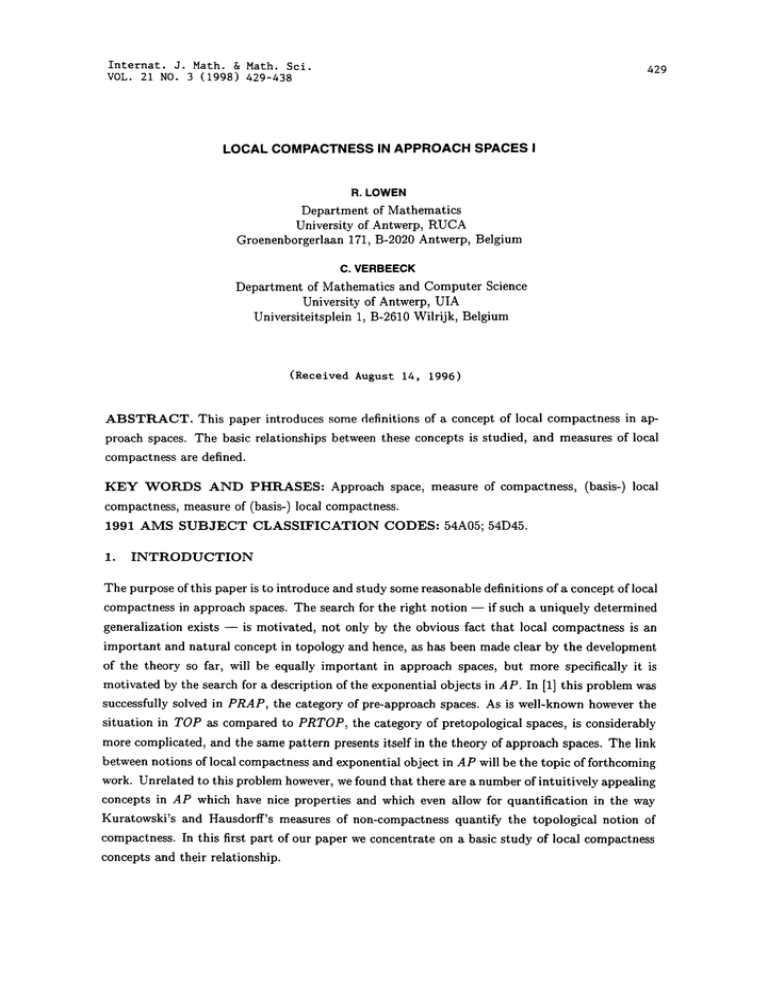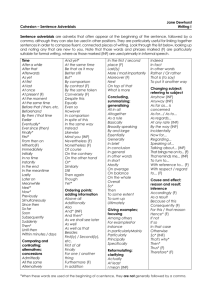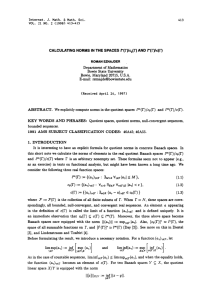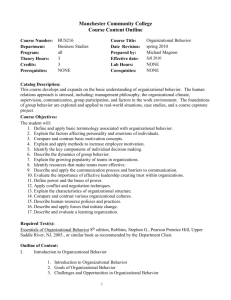COMPACTNESS IN APPROACH SPACES Department Antwerp, UIA LOCAL
advertisement

Internat. J. Math. & Math. Scio
VOL. 21 NO. 3 (1998) 429-438
429
LOCAL COMPACTNESS IN APPROACH SPACES
R. LOWEN
Department of Mathematics
University of Antwerp, RUCA
Groenenborgerlaan 171, B-2020 Antwerp, Belgium
C. VERBEECK
Department of Mathematics and Computer Science
University of Antwerp, UIA
Universiteitsplein 1, B-2610 Wilrijk, Belgium
(Received August 14, 1996)
ABSTRACT. This paper introduces some definitions of a concept of local compactness in approach spaces. The basic relationships between these concepts is studied, and measures of local
compactness are defined.
KEY WORDS AND PHRASES: Approach space, measure of compactness, (basis-) local
compactness, measure of (basis-) local compactness.
1991 AMS SUBJECT CLASSIFICATION CODES: 54A05; 54D45.
1.
INTRODUCTION
The purpose of this paper is to introduce and study some reasonable definitions of a concept of local
compactness in approach spaces. The search for the right notion if such a uniquely determined
is motivated, not only by the obvious fact that local compactness is an
generalization exists
important and natural concept in topology and hence, as has been made clear by the development
of the theory so far, will be equally important in approach spaces, but more specifically it is
motivated by the search for a description of the exponential objects in AP. In [1] this problem was
successfully solved in PRAP, the category of pre-approach spaces. As is well-known however the
situation in TOP as compared to PRTOP, the category of pretopological spaces, is considerably
more complicated, and the same pattern presents itself in the theory of approach spaces. The link
between notions of local compactness and exponential object in AP will be the topic of forthcoming
work. Unrelated to this problem however, we found that there are a number of intuitively appealing
concepts in AP which have nice properties and which even allow for quantification in the way
Kuratowski’s and Hausdorff’s measures of non-compactness quantify the topological notion of
compactness. In this first part of our paper we concentrate on a basic study of local compactness
concepts and their relationship.
430
R. LOWEN AND C. VERBEECK
PRELIMINARIES
2.
Given a set X we denote its power set by 2 x and the set of its finite subsets by 2 (x). We recall
those concepts and results from Lowen [2, 3] which we require in the sequel. A map
:X x 2 x
[0, c]
is called a distance if it fulfils
(D1) VA 2X,Vx X
A
x
5(x,A)
O.
(D2) Vx X: 5(x,0)
(D3) VA, B 2 x, Vx X: 5(x, A t2 B)
5(x, A) A 6(x, S).
(D4) VA 2X,Vx X, Ve [0, o] :6(x,A) <_ 5(x,A()) + e where
A ()
:=
-
{x[5(x,A) <_ e}.
If is a distance on X and A C X, the function 6A X [0, oo] is defined by 5A(x) :=
A collection (,4(x))xex of ideals in [0, o] x is called an approach system if it fulfils
(A1) Vx
X, V
4(x) v(x)
0.
5(x,A).
(A) W e X, V e [0,
(V, N
]0, oc[, 3 ,4(x) v A N _<
+ e)
=o
A(x).
(AS) Vx X, Vo A(x), VN 10,
3(v,),ex
I] A(z), Vz, y
X: o(y) A N < x(z) + o,(y).
zEx
The elements of an approach system are called local distances. For ease in notation we shall,
whenever convenient denote an approach system (A(x)),ex also simply A.
If A is an approach system then A := (A(x))ex is called a basis for A if it fulfils the properties
(bl) Vx X A(x)
is a basis for an ideal.
(b2) Vx X: .A(x) =/it(z) where
/(x) := { [0, oc] x V,N ]0,o0[,=t h(x): ^N_< +e}.
PROPOSITION 2.1 [3]
1.
If 4 is an
6t" X x 2x
is a distance on
$.
If 6
-
approach system on X then the map
X.
[0, oo]" (x, A)
is a distance on X then the system
A,(x)
sup inf qo(a)
At where for all x X
{ [0, o01 x VA c X-inf
o(a) < 5(x,A)}
aA
is an approach system on X.
LOCAL COMPACTNESS IN APPROACH SPACES I
3..A.
.,4 and 6.a
431
6.
A set X equipped with an approach system or equivalently a distance is called an approach space
and is usually denoted (X, Jl). The associated distance is usually denoted simply 6 instead of
6A and analogously if 5 is the primary defined structure, A is usually simply denoted ,4, unless
confusion might occur.
PROPOSITION 2.2 [3] If A
is a basis for ,4 then
(,a)
is also obtained by
sup
If (X, ,4) and (X’, 4’) are approach spaces and f X
if it fulfils any of the following equivalent (see Lowen
(el) Vz X, Vo’
.
X’ is a map then f is called a contraction
[3]) conditions:
A’(f(x)) o’ o f
(c2) For any basis h’ for Ar, Vx X, re’ A’(f(x))
(c3) Vx X, VA C X: ’(f(x), f(A)) <_ (x,A).
’
o
f e A(x).
Approach spaces and contractions form a topological construct Lowen [3] which we denote AP.
For categorical concepts, in particular topological categories, we refer to Admek et al. [4]. TOP
can be embedded as a bireflective and bicoreflective subconstruct of A P. The embeddingsfunctor
is given by (X, 7") --+ (X, AT) leaving morphisms unaltered and where AT is the approach system
AT(x) := {o [0, c] x o(x) 0, o u.s.c, at x} for every x X, and which has as basis the
V and
0 if x
collection {Or V neighborhood of x for T} for every x X, where Or(x)
if
and 6(x, A)
Oy(x) cx if x V. The associated distance is given by 6(x, A) 0 if x
of
the
bicoreflection
that
We
recall
to
TOP.
The subconstruct thus obtained is isomorphic
x
(X,A) in TOP is given by idx (X,,4-a) -+ (X, JI) where 7 is the topology on X determined
.
by the neighborhood system
or equivalently by the closure operator
:=
{x X (x, A)
0} for every A 2 x.
-
The construct pq-MET of extended pq-metric spaces and non-expansive maps too can be
embedded as a bicoreflective subconstruct of AP. The embedding is given by (X, d)
(X,)
leaving morphisms unaltered and where Ad is the approach system
J[d(x) := {o [0, ]x [o _< d(x,-)}, Vx e X
with obvious basis consisting of the single element d(x, .). As to be expected the associated
distance is given by 6(x, A) infaea d(x, a).
As for topological spaces a convergence theory can be developed in AP (see E. and R. Lowen
[5, 6] for more details). The difference with topological spaces however is that with each filter and
each point we can give a distance the point "is away from being a limit point" of the filter. Precisely
this goes as follows. Given a set X, F(X) is the set of all filters on X; if E F(X), then U(’)
is the set of all ultrafilters finer than ’. If C 2 x then stackx := {B C X G E
G c B},
"
432
R. LOWEN AND C. VERBEECK
if G consists of a single set G we write stackxG and if moreover G consists of a single point a, we
write stackxa for short. If no confusion can occur, we drop the subscript X. Also, if F C X we
abbreviate U(stack F) by U(F). The set sec is defined as the union of all ultrafilters finer than
A A F # 0}. Let (X, 5) be an approach space and
’, which means sec := {A C X VF E
:F F(X), then the limit (-function) of is defined as
"
"
"
’(z)
:= sup
AEsec
(f(z, A), Vz X.
It will be useful also to have a description of 6 not in terms of 6 but in terms of the associated
approach system t.
PROPOSITION 2.3 [7] Let (X, .A) be an approach space. For any yz E F(X) and x E X
we have
AAgV(x)= sup inf_supo(y)
where both .4 and .T may be replaced by bases.
It is worthwile to mention that limits also as in TOP provide yet a third way to describe approach
spaces (see E. and R. Lowen [5] for more details). For us it suffices to mention that the distance
5 can be recovered from 6 by
inf )lJ(x).
(x,A)= uu(A)
-
Convergence in the topological bicoreflection (X, 7) of an approach space (X, 5) can easily be
"
"
x in T if and only if (x) 0.
derived from the limit associated with 5. If
F(X) then
In the case of cx)-pq-metric spaces the associated limit takes on a more simple and intuitive
form. If
"
and in case
E
F(X) then
inf sup d(x, y),
Y(x)
"
is generated by a sequence
F. yF
(x,), this simply means that ’(x)
lim sup d(x,
DEFINITION 2.4 Given an approach space (X,A), we define the measure o.f compactness
oI X
as
#c(X)
sup inf /(x).
uev(x) ex
The idea behind this definition is the following. Compactness means every ulrafilter should
have a convergence point. Therefore the information given by #e is based on the verification for all
ultrafilters what are their "bes convergence" points. Before all else we give a number of equivalent
forms of this definition.
PROPOSITION 2.5 [2] For any approach space (X, riO, we have
(X)
sup
inf sup inf (x)(z)
sup
inf sup inf (x)(z)
pEI’I=x A(=) YE2(x) zEX
cEl-[=x A(x) YE2(X) zEX xEY
where A is a basis for the approach system A.
LOCAL COMPACTNESS IN APPROACH SPACES I
433
THEOREM 2.6 [2]
1.
If (X, AT)
2.
If (X,‘4d) is
u(x) =o.
3.
If (X, ‘4d)
is a topological approach space then
(X, T)
an o-pq-metric approach space then
is a pq-metric approach space then
(X, d)
is compact
(X,d)
if and only if u(X)
is totally bounded
is bounded
O.
if and only if
if and only if #(X) <
.
THEOREM 2.7 [2]
and (X’,A’) are approach spaces and
contraction then #e(X’) < #e(X).
1.
If (X,A)
2.
If (X, Aj)Ij
is a family
(X,A)
f
(X’,A’)
is a surjective
of approach spaces then
SOME NOTIONS OF LOCAL COMPACTNESS IN AP
3.
In this section we will define some notions of local compactness and basis-local compactness in
A P, which on topological spaces coincide with the topological notions of local compactness and
basis-local compactness. We will denote the notions of local compactness by LCn where n is a
number between 1 and 5, and the associated notions of basis-local compactness likewise by BLCn.
DEFINITION 3.1 Let (X,,4) be an approach space.
1.
(X, ,4)
2.
Define
is LC1
if and only if its topological coreflection is locally compact.
(x,.)
where
])(x)
Lee
==
Yx
,=,
v e x, v e v(): o(v) o,
is the neighborhood filter
of x
X, VY
x, 3F
in the topological
Y #(F)
coreflection.
Define
(X, .,4)
is LC3
==
Yx X,.T x- inf (F)
F{"
VxX" inf #c(V)=O
0
vv(x)
,=, Vx
X, Ve > 0,3iv A(z),3 > 0:
({ < 6}) <
4. (X,‘4)
is
.
LC4 if and only if
VxX,’v’e>O: inf (F)<e,
FeV,(x)
where ))e(x):= stack {{iv < } iv
‘4(x)}.
0
434
5.
R. LOWENAND C. VERBEECK
(X, ,4)
is LC5
if and only if
VxX, Ve>0" inf pc(F)< inf
It is easily verified that the given definitions of LC2 are equivalent, and likewise are those of LC3.
We have the following obvious relations between the different LCn.
LC2
PROPOSITION 3.2 LC1
PROPOSITION 3.3 Let (X, T) be
Then (X, T) is locally compact
(X, AT-) is LC (X, AT-) is LC5.
LC3
LC4
LC5.
a topological space.
This is a straightforward result and it shows the LCn can be considered as generalizations of
topological local compactness in the context of approach spaces. Notice that for a topological
space, Ve(x) V(x) for every e > 0 and every x X.
PROPOSITION 3.4 1. Let (X, d) be an oc-pq-metric space. Then (X, d) is LC2 if and
only if every point possesses a totally bounded neighborhood.
2. Every c-pq-metric space is LC3 and
LC4.
PROOF.
(X, d) be an x-pq-metric space. Then (X, d) is LC2 if and only if Vx X, 3V l)(x)
#c(V) 0. Denote the open ball with center y and radius e by B(y,), then pc(V) 0 if
and only if Ve > 0, 3Y 2 (v) V C [.Jy B(y, ), if and only if V is totally bounded.
1. Let
2. Since LC4 implies LC3 we only have to show every c-pq-metric space (X, d) is LC4. Now
(X, d) is LC4 if and only if for every x X and every e > 0, inffev,(x)pc(F) _< But
. .
B(x,e) belongs to ])e(x) and by adapting the first part of the proof we see #c(B(x,e)) <_
For every LCn, we will introduce a corresponding notion BLCn of basis-local compactness.
DEFINITION 3.5 Let (X,.4) be an approach space.
1.
(X,A)
is BLC1
if and only if its TOP-coreflection is basis-locally compact.
2.
(X, ,4)
is BLC2
if and only if
Vx
3.
(X, ‘4)
is BLC3
X, VV 12(x), SW V(x) W C V and #c(W)
if and only if
VxX- sup
inf
VV(x) wv()
WCV
4- (X,A)
is
#(W)=0.
BLC if and only if
VxX, Ve>0,VFre(z),Ve’<e- inf #c(G) <
(z)
GE
GCF
O.
LOCAL COMPACTNESS IN APPROACH SPACES I
(X, .,4)
5.
is BLG5
435
if and only if
V(z) V’ < e" inf #(G) < inf SVe(x)(y).
Vx fi X,V > O, VF
GCF
If an approh space is BLCn, then it is also LCn. In order to see this, notice that we have
Ye(x) ,<e,(x) for eve x X and > 0. The relations between the different BLCn are
for the LCn:
PROPOSITION 3.6 BLC1
BLC3
BLC2
PROPOSITION 3.7 Let (X, T) be a topologil sce.
(X, T) bas-locally compact (X, AT)
(X,A) u BLC4 (X,A) is BLC5.
Then
This rult illustrates the BLCn can be ewed
ptness in the context of approach spaces. For
1. Let
PROPOSITION 3.8
(X, d) be
(X, Av)
BLC1
BLC2
(X, AT)
BLC3
generalizations of topological bis-local com--metric spaces, we get the following result.
an -pq-metric space. Then
(X, d)
of totally bounded neighbor-
and only i/every point possesses a neighborhood b coisting
hoo&.
Eve --metc space is BLC3 and BLC.
2.
For some notions of local compactness in AP we can introduce a meure of local comptns
which is a generalization in which all the nice properti are preserved.
DEFINITION 3.9 Let (X, A) be an approach space.
Lc3(X)
UBZC(X)
:= sup inf
x vv()
:= sup sup
inf
xX V() wv()
WCV
(
:=
zeX >0
.BLc4(X)
pc(V).
v o.
:= supsup sup sup
(
inf
,c(G)
e’) V O.
GCF
U5cs(X) := supsup (
xx >0
Lcs(X)
For n
inf
:= supsup sup sup
xx >0 FV,(x)’<
{3, 4, 5}, ()Lcn(X)
u(F)
inf
inf c(G)
( av(,)
AV(x)(y)) V 0.
inf AV,, (x) (y)) v 0.
yx
GCF
is called the meure
of (b-)
local compactness of X. This is
justified by the follong proposition.
__
PROPOSITION 3.10
then ()Lc(X)
0
I (X,A)
if and oy if (X,A)
an approach space and n
{3, 4, 5},
(B)L.
The following inualities can eily be check.
PROPOSITION 3.11 Let (X,A) be an appwach space. Then
.
1. For all n
[A(B)LC3(X)
](B)Lc4(X)
I(B)Lcs(X).
B
436
R. LOWEN AND C. VERBEECK
COUNTEREXAMPLES
4.
Proposition 3.2 gives some relations between the different notions of local compactness in A P. In
this section, we will show these relations are really all there is to find, except perhaps LC4 LCb.
=
1.
Note that there exist approach spaces which are not LC3, for instance, every topological
space which does not possess local compactness.
:) LC1, just consider the metric space (d, d) of rational numbers with the
euclidean metric. Every point possesses a totally bounded neighborhood, so ((, d) is LC2.
But clearly the topological coreflection is not locally compact, so ((, d) is not LC1.
2. To prove LC2
LC2. To this end, consider the metric (Hilbert) space (12, d).
is LC4. We already know that for all x 6 and all e > 0,
We shall prove that also inft2 Ar(x)(y) > 6:
3. We shall now show LC5
Since it is a metric space,
infet2 Ar(x)(y) < 6.
(l 2, d)
infAVe(z)(y)
Y 6-.12
inf
sup
6(y,A)
inf
sup
inf d(y,a).
Y 12 A.sec Ve(x)
Y 6--12 ACB(z,e)#$ a6..A
Now take y 6 12. Ify 9 B(x,e), define A := {x}, then it is obvious that ACIB(x,e) :/:. and
infaeA d(y,a) d(y,x) >_ 6. If y 6_. B(x,e) \ {x}, we can find some y’ 6 B(x,e) such that
d(y, y’) _> e. In that case, choose A := {y’}. If y x then supanB(,e)# infae A d(x, a) 6.
Hence we can conclude infet AVe(x)(y) e. This implies (/2, d) is also LCb. Since no point
in (/, d) has a totally bounded neighborhood, (/, d) is not LC2.
4.
-
In order to see LC1 LC4, consider the following approach space (X, A): Let X be a set,
a filter on X and f" X
[0, oo] a function. If ; is a filter on X and x 6 X, we define
f(x) if Y stack x C O and ; # stack x
stackx g ;
Ag;(x) A(j);(x):= oo if
0
’
if ;
stack x.
In E. and R. Lowen [6] it was shown that (X, A) is an approach space. Moreover, if H is an
ultrafilter on X and x 6 X,
f(x) if’CHandH#stackx
if /2 and H # stack x
AH(x)
o
0
"
if H
stack x.
,
If there exists an x 6 X such that H stackx, then inf,x A/g(x) 0. If for every element
x e X, H # stack x and Y C then inf, ex AH(x) infzex f(x). If for every element x of X,
/4 # stack x and fZ H, then infzx A/4(x) oo. So we get the following three cases. If X is
finite (i.e., all ultrafilters on X are point filters), then #c(X) supuev(x) inf, ex AH(X) 0.
If X is infinite and if for every ultratilter H on X, not being a point filter,
C H, then
p(X) influx f(x). Finally, if X is infinite and there exists some ultrafilter/4 on X,
not a point filter, such that
if H, then #(X) oo. Let B be the intersection of all
ultrafilters on X which are not a point filter. A straightforward verification shows that
B {X \ A A is finite}. Using this fact, we can state
"
"
"
if X is finite
inf,x f(x) if X is infinite and Y C {X \ A A is finite}
c
if X is infinite and 9v {X \ A A is finite}.
0
#c(X)
LOCAL COMPACTNESS IN APPROACH SPACES I
In the sequel we will suppose X is infinite,
and
f
is an ultrafilter on
437
X with only infinite elements,
X,
o. Then for every ultrafilter L/on
f(x)
if’=L/
0
if .T /2 and L/# stackx
if/,/= stack x.
AL/(x)
In order to know VE(x) we need to find A(x).
inf (z) < M2(x)
A(x) * Vbl U(X) Usup zEU
Ebl
sup in[ (z) < f(x) and sup inf (z)
zU
zF
0
U stk
F
sup inf (z)
FzF
</(x) and (x)
0.
We infer
V(x)
stack
{{qa < e}
sup inf (z)
F6.. z6.F
< f(x) and q(x)
0}.
Notice that for any G C X the initial structure on G is given by A(yG,I,a and consequently
the expression for #c(G) is obtained by replacing X by G in the expression for #c(X). Hence
we get
#c(G)
inf
inf
0 if there exists some finite G
#e(G)
inf f(z) if every G
inf
{C\A
inf
aev(x)
VE(x)
A is finite}D.’l
is infinite and there exists some
(G \ A
V(x),
IA is finite} D ’IG,
and
#c(G)
G
oc if every
G
l)(x) such that
Ve(x)
is infinite and satisfies
{G \ A[A is finite} ;fi -O-
.
If we take e > f(z) then V(z) contains only
Consider some x X such that f(x) <
infinite elements: if qa satisfies supF.infzFp(z < f(x) and (x)
0, then for every
and for every O > 0, there exists some z F such that (z) < f(z) + g, so { < }
F
is an ultrafilter containing only infinite elements. The fact that
is infinite, for
is an
ultrafilter also implies that {G \ A A is finite}
-G for every G V(x), So we can
"
conclude
"
infGv,(x)#,(G)
"
c
> s, whence (X, A)
is not LC4.
Now choose a function f as before, but moreover satisfying f > 0. For every x
(z) stack x, so {x} is a compact neighborhood of z. This means (X, ) is LC1.
X,
REFERENCES
[1] LOWEN, E., LOWEN, R., and VERBEECK, C., Exponential objects in the construct PRAP,
UIA internal report 96-09 (1996).
[2] LOWEN, R., Kuratowski’s measure of non-compactness revisited, Quart. J. Math. Oxford
(2) 39 (1988), 235-254.
[3] LOWEN, R., Approach spaces: the missing link in the topology-uniformity-metric triad,
Ozford Mathematical Monographs, Oxford University Press (1997).
438
R. LOWEN AND C. VERBEECK
[4] AD/i.MEK, J., HERRLICH, H., and STRECKER, G.E., Abstract and concrete categories,
John Wiley (1990).
[5] LOWEN, E. and LOWEN, R., A quasitopos containing CONV and MET as full subcategories, Internat. J. Math. 8J Math. Sci. 3 (1988), 417-438.
[6] LOWEN, E. and LOWEN, R., Topological quasitopos hulls of categories containing topological and metric objects, Cah. Top. Gdo. Diff. Cat. 30:3 (1989), 213-228.
[7] LOWEN, R., A topological category
Theory 56 (1989), 108-117.
suited for approximation theory?,
J. Approximation





